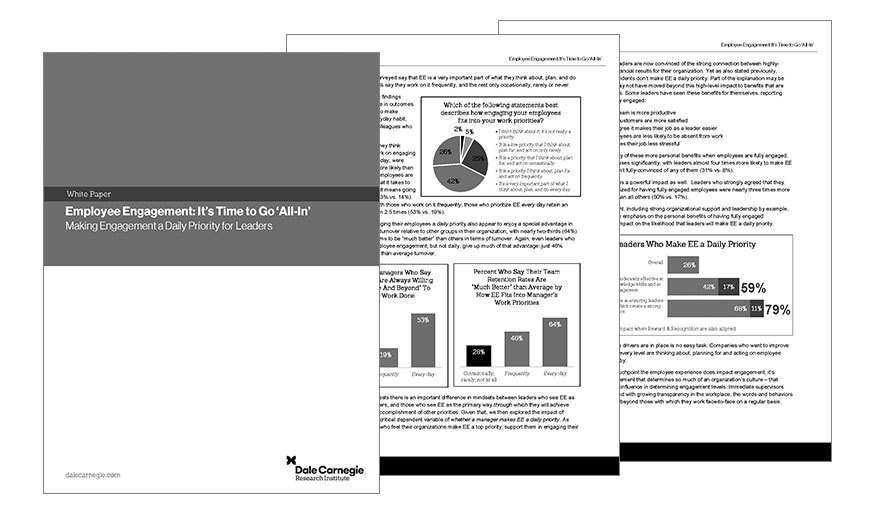
What is Employee Engagement?
At Dale Carnegie, we define employee engagement as the level of psychological and emotional commitment an employee has to their organization.
The Statistics: How Many Employees are Fully Engaged?
While employee engagement inched up in 2019 according to some studies, our research shows that only 30% of the workforce is fully engaged (Employee Engagement: Time to Go All In). These employees are enthusiastic, conscientious about their work, and go above and beyond. They are the ones you wish you had more of.
Disengaged employees, on the other hand, coast at best. At worst, they sow chaos and discord among their teams. While only about 1 in 5 (19%) of employees are actively disengaged, that can add up to a tremendous drag on any organization.
The vast middle—the 51% of the workforce that’s partially engaged—could go either way. These employees do a decent job most of the time, but they don’t always give their best effort and rarely go above and beyond what is expected of them. Anyone who’s ever called a customer service line can tell you how often that happens.
The trick is to minimize disengagement and move as many people as possible from partially engaged to fully engaged.
Engagement Is NOT the same as “Employee Experience” or “Employee Satisfaction”
Don’t fall prey to believing that employee engagement is synonymous with the employee experience or employee satisfaction. It’s not.
A great employee experience does not necessarily mean great employee engagement. Why? Because employee engagement involves an emotional element that cool technology, mandatory team activities, open workspaces or a kegerator in the kitchen don’t elicit.
Employee engagement is about feeling—feeling valued, confident, connected and empowered. Feeling motivated. A ping-pong table in the breakroom isn’t going to evoke that.
Beware of getting complacent because of decent employee satisfaction rates, too. Employees can be satisfied with lots your organization has to offer—starting with the fact that they have a job. But that doesn’t mean they’re fully engaged. Yes, they’re present and they’re working. But being engaged is something else entirely.
More Than a Buzzword: The Importance of Employee Engagement
The organizations that study employee engagement, including Deloitte, Gallup, Willis Towers and others, say that increasing employee engagement rates leads to remarkable improvements in business metrics. For starters, organizations with engaged employees:
- Increase productivity by 17%
- Boost profits by 21%
- Lift sales by 20%
- Improve employee retention by 24%
- Reduce shrinkage by 28%
- Improve customer satisfaction by nearly 10%
If yours is like most organizations, however, only 30% of your employees are fully engaged. That means you’re missing out on these great results highly engaged organizations realize.
Why Aren’t Employee Engagement Rates Taking Off?
Although 85% of CEOs say employee engagement is a top priority, most organizations are falling short in their efforts to increase their employee engagement levels.
With that much C-level firepower behind an initiative, along with the billions of dollars being spent on everything from surveys to wellness programs, you’d expect employee engagement rates to be climbing by a lot. But most studies show that they are barely trending upward.
Overall, the rate of fully engaged employees has been pretty flat (within a few percentage points) since the turn of the century when Gallup first started measuring engagement. Our research shows the same thing. So, what’s holding it back?
What Factors Drive Employee Engagement?
According to Dale Carnegie research, the top three dynamics that impact employee engagement rates are:
- Pride in the organization
- Trust in senior leadership
- Relationship with an employee’s immediate manager
What do these factors have in common? They’re emotional. And personal. Despite what some might say, work is personal. Think about it. If you’ve ever lost your job, didn’t you feel betrayed? The HR manager might have said it wasn’t personal, but it sure felt personal. Organizations with high engagement know this.
- Pride in the organization. Maybe you remember seeing your organization’s logo on trucks delivering hurricane relief to families forced out of their homes by floods or represented at a local charity event. Feeling proud knowing that was your company…that’s an emotion sparked by your organization.
For an organization to elicit feelings of pride, it must embrace a purpose, manifest values and aspire to results that meet employees’ standards of worthiness. But that’s not enough. The organization’s leaders must model the culture they are trying to create.
As a manager, your behavior communicates volumes to your employees. If you’re out of sync with your organization, chances are your employees are, too. Our data show that about half of employees were disengaged if they perceived their manager to be disengaged.
- Trust in senior leadership. Each employee develops trust in leadership (or not) through their own experience with their organization’s leaders. As a manager, you can only affect what’s in your circle of influence, which means your cheerleading on senior leadership’s behalf won’t move the needle. It’s up to them to build that trust through their own actions.
And if you’re a senior leader with direct reports? Everything here applies to you as well. Not only are you responsible for engaging them, you’re also responsible for being an excellent example of how it’s done.
- Your relationship with employees. Engagement comes from feeling valued. Feeling confident. Feeling connected. Feeling empowered.
To build those feelings within your employees, think about employee engagement the way you do your other interpersonal relationships, like with family, friends, neighbors, the little league team, church volunteers and others. The key to all of these is that they evoke feelings and emotions. Employee engagement requires the same thing.
It sounds easy enough. But developing and nurturing interpersonal relationships takes time and attention. Let’s look at what you can do to connect with your team.
3 Strategies Amazing Managers Use to Increase Employee Engagement
There’s no shortcut to developing strong relationships with each of your employees. But there is a clear path:
- Develop excellent interpersonal skills
- Engage in authentic conversations
- Recognize unique talents and reward accomplishments
And do them on a daily basis. Teams with managers who make employee engagement a daily priority are almost three times more engaged than teams whose managers do not. In other words, you can propel your team and your organization to higher levels of engagement if you just take the time and focus on doing the right things until they become a habit.
Organizations Need All Their Managers on the Same Page
Employee engagement isn’t a project or something you dabble in. It requires a commitment from every manager at every level of your organization. Leadership has to paint the vision. It must make employee engagement a strategic priority and treat it like any other strategic priority it spends time and resources on.
Now that you have the basics, let me know what specific challenges you face. Sign up for this blog if you want to hear more about employee engagement or check out our white papers on employee engagement to jumpstart your journey.


